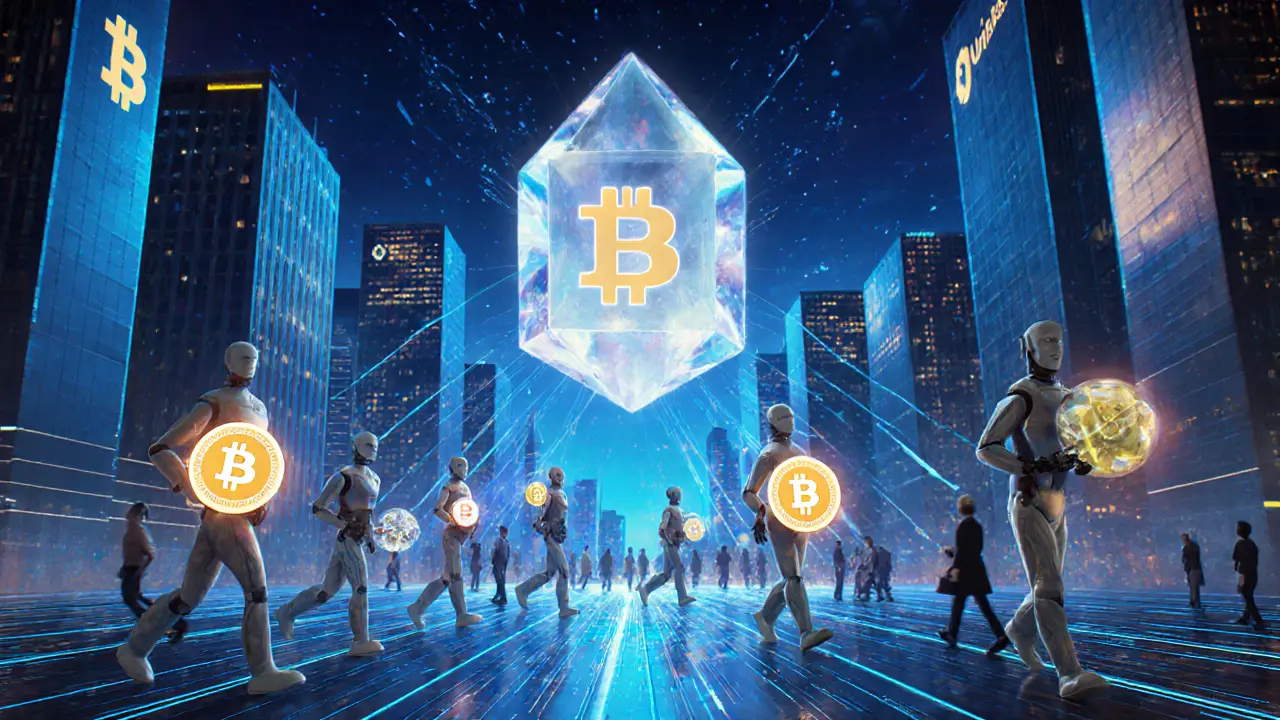Memory Storage Cost Calculator
Storage Cost Calculator
Calculate the UB token cost for storing AI agent memory entries on Unibase's decentralized memory layer. Based on $0.001 per KB storage fee.
Estimated Costs
CoinMarketCap: $0.0436 | CoinGecko: $0.0431 | Blockspot.io: $0.0277
Unibase (UB) isn’t just another crypto coin. It’s a decentralized AI memory layer built to solve a problem most people don’t even know exists: how do AI agents remember things? If you’ve ever talked to a chatbot that forgets your name halfway through the conversation, you’ve felt this gap. Unibase fixes that - but it’s not for casual traders. It’s infrastructure for the next wave of autonomous AI systems.
What Unibase Actually Does
Most AI agents today are like short-term memory patients. They can answer your question right now, but if you come back tomorrow, they’ve forgotten everything. Unibase changes that. It gives AI agents persistent, secure, on-chain memory. Think of it like a cloud drive for AI minds - but one that can’t be shut down, censored, or hacked by a single company. The protocol has four core parts:- On-Chain Identity: Every AI agent gets a verifiable, tamper-proof identity on the blockchain.
- Decentralized Memory: Agents store memories (like user preferences, past decisions, learned patterns) across a global network of nodes.
- Multi-Agent Interoperability: An AI agent built on Unibase can share memory with another agent on a different platform - no APIs needed.
- Continuous Self-Evolution: Agents learn from their own history and improve over time without human input.
This isn’t science fiction. As of September 2025, over 12.4 million memory entries have been recorded on Unibase’s testnet. Projects like TradingFlow (autonomous crypto traders) and TwinX (self-improving AI assistants) already use it. One user reported memory retrieval speed dropped from 2.1 seconds to 0.35 seconds after switching to Unibase.
How the UB Token Works
The UB token is the fuel for this entire system. It’s not a speculative asset - it’s a utility token with clear, technical uses:- Memory Storage Fees: $0.001 per KB of data stored.
- Agent Deployment: You need UB to launch an AI agent on the network.
- Interoperability Payments: When one agent accesses another’s memory, it pays in UB.
- Governance: Holders can lock UB into veUB to vote on protocol upgrades.
- Staking: Premium AI agents require a minimum of 10,000 UB staked to operate.
- Knowledge Mining: Users who contribute useful data to the network earn UB rewards.
The total supply is fixed at 10 billion UB. Only 2.5 billion are in circulation as of September 2025 - meaning 75% are locked for future ecosystem growth. This structure is intentional: the team wants to avoid dumping tokens on the market and instead build real usage first.
Where You Can Buy UB
Unibase launched on September 12, 2025, on Ethereum and BNB Chain. You’ll find UB on 65 exchanges, but the biggest by volume is Binance, handling over 32% of all trades. Other major listings include KuCoin, Gate.io, and MEXC.Price varies slightly across platforms. As of late September 2025:
- CoinMarketCap: $0.0436
- CoinGecko: $0.0431
- Blockspot.io: $0.0277
These differences come from liquidity gaps and trading pairs. Always check volume - low volume means big price swings. The 24-hour trading volume across all exchanges sits around $25 million, which is healthy for a new protocol but still small compared to top 100 coins.

Who’s Using It (And Why)
Unibase isn’t for people who want to flip coins. It’s for developers building AI agents that need to remember users, adapt over time, and work across platforms. Here are real examples:- TradingFlow: Autonomous trading bots using Unibase memory saw a 47% increase in profit accuracy because they remembered past market behavior and user risk profiles.
- BitAgent: A multi-agent platform where different AI assistants collaborate - one handles scheduling, another researches prices, and they all share memory via Unibase.
- TwinX: An AI companion that evolves based on your conversations. The more you use it, the better it knows you - and that memory lives on-chain, not in a corporate server.
- Beeper: A Twitter-integrated AI that replies to tweets based on your preferences. It doesn’t forget your tone, favorite topics, or past replies.
These aren’t prototypes. They’re live, running, and paying UB fees daily. The network has over 67,000 unique token holders - and 18.7% of circulating supply is held by institutions.
Why It’s Different From Fetch.ai, Ocean Protocol, or Bittensor
People often compare Unibase to other AI-blockchain projects. Here’s the real difference:- Fetch.ai: Focuses on agent economies and automation - but doesn’t solve memory storage.
- Ocean Protocol: Lets you buy and sell data - but doesn’t help agents remember or learn.
- Bittensor: Rewards machine learning models - but doesn’t give them persistent, cross-platform memory.
Unibase is the only one built from the ground up to be the memory layer for AI agents. It’s like the difference between building a car (Fetch.ai) and building the fuel station network that makes all cars work (Unibase).
Technical Requirements and Costs
Running a storage node on Unibase isn’t cheap. You need:- 16GB RAM
- 500GB SSD storage
- 100Mbps internet connection
Gas fees on Ethereum are a pain point. Writing a single memory entry costs about $1.27 on average - but during congestion, it spikes to $3.50. That’s why the team is rolling out Layer 2 support on Arbitrum and Optimism by the end of 2025.
For developers, the learning curve is steep. You need to know Solidity (for smart contracts), TypeScript (for AI agent code), and how vector databases work. Onboarding takes 3-5 days for blockchain devs, but up to 3 weeks for AI researchers new to Web3.

Pros and Cons
Pros:- Solves a real, unaddressed problem in AI: persistent memory.
- Strong developer adoption - 142 contributors on GitHub, 478 commits in 30 days.
- Clear token utility - not just speculation.
- High uptime: 99.98% during stress tests with 1,000 concurrent agents.
- Comprehensive docs and active Discord community (12,450 members).
- Ethereum gas fees are still too high for small-scale use.
- Only supports MetaMask, Trust Wallet, and Unibase’s own wallet - no Ledger or hardware wallet yet.
- 75% of tokens are locked - future unlocks could cause price pressure (1.25B UB scheduled for Q1 2026).
- Complex for non-developers. Not a “buy and hold” coin.
What’s Next for Unibase
The roadmap is aggressive:- October 15, 2025: Testnet launch of zk-backed memory verification (privacy-preserving data checks).
- Q4 2025: Full integration with Arbitrum and Optimism to cut gas costs.
- Q2 2026: Integration with DePIN networks - allowing physical devices (like home servers) to contribute storage.
Industry analysts from Messari predict Unibase could capture 35-40% of the AI agent infrastructure market by 2027 - if it scales without latency issues. Gartner warns that cost efficiency will be the make-or-break factor.
Is Unibase Worth It?
If you’re a trader looking for the next 10x coin, Unibase is risky. The tokenomics are designed for long-term protocol growth, not quick flips. With only 25% of supply circulating and major unlocks coming, volatility is guaranteed.If you’re a developer building AI agents - or even just curious about how AI will remember things in the future - Unibase is essential infrastructure. It’s not just a coin. It’s the backbone of a new kind of internet: one where AI doesn’t forget you.
Right now, it’s still early. The network is small. The tech is unproven at massive scale. But the problem it solves? It’s real. And no one else is building it.
What is Unibase (UB) crypto coin used for?
Unibase (UB) is the native token of a decentralized AI memory layer. It powers storage fees for AI agents, pays for cross-agent communication, enables governance voting, and is required to deploy or stake AI agents on the network. It’s not a currency for buying goods - it’s the fuel for autonomous AI systems that need to remember and learn.
Can I mine Unibase (UB)?
No, you cannot mine UB. Unibase uses a proof-of-stake model on Ethereum and BNB Chain. The only way to get UB is to buy it on exchanges or earn it through knowledge mining - contributing useful data to the network, which rewards participants with tokens.
Is Unibase a good investment?
It depends on your goals. If you’re looking for short-term gains, UB’s tokenomics make it risky - 75% of tokens are locked, and large unlocks are coming in 2026. If you believe in the future of autonomous AI agents and want to support infrastructure that solves real technical problems, then UB has long-term potential. It’s not a speculative play - it’s a bet on AI infrastructure.
Where can I store my UB tokens?
UB is an ERC-20 token on Ethereum and a BEP-20 token on BNB Chain. You can store it in MetaMask, Trust Wallet, or Unibase’s official wallet. Hardware wallets like Ledger are not yet supported, which is a current limitation for security-focused users.
How does Unibase compare to Fetch.ai or Ocean Protocol?
Fetch.ai builds AI agents that automate tasks, but doesn’t give them persistent memory. Ocean Protocol lets you trade data, but doesn’t help agents learn from it. Unibase is the only one focused on giving AI agents long-term, cross-platform memory that they can use to evolve. It’s not a competitor - it’s the missing layer they all need.
Is Unibase regulated?
Unibase has proactively engaged with Swiss financial regulators to establish compliance frameworks. While its governance features could trigger security classification in some countries, the team is working to ensure the protocol meets legal standards. Always check your local regulations before investing.
Can I run a node for Unibase?
Yes, but it’s technical. You need a server with 16GB RAM, 500GB SSD, and 100Mbps internet. You also need to understand blockchain infrastructure and be comfortable with Linux command line. Node operators earn UB fees from memory storage requests, but the setup isn’t beginner-friendly.
What’s the total supply of UB?
The total supply of UB is fixed at 10 billion tokens. As of September 2025, only 2.5 billion (25%) are in circulation. The rest are locked for ecosystem development, team incentives, and future grants, with scheduled unlocks over the next 10 years.
Unibase isn’t trying to be the next Bitcoin. It’s trying to be the foundation for a new kind of digital intelligence - one that remembers, learns, and evolves. If that sounds like the future, then UB is worth paying attention to.
Soham Kulkarni
November 24, 2025 AT 00:15unibase sounds like something that shouldve been built 5 years ago but better late than never i guess
Jennifer MacLeod
November 24, 2025 AT 19:10imagine if your ai assistant remembered your favorite coffee order and your exs birthday and your cats name all in one place